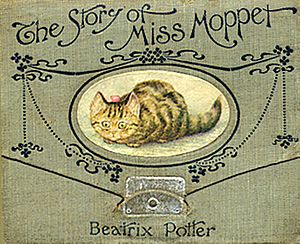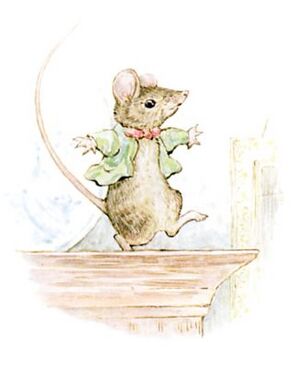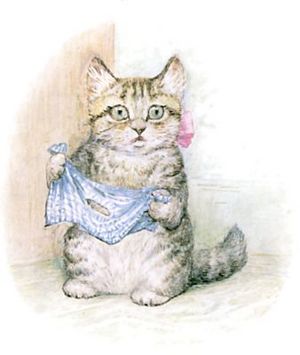The Story of Miss Moppet facts for kids

First edition cover
|
|
| Author | Beatrix Potter |
|---|---|
| Illustrator | Beatrix Potter |
| Country | England |
| Language | English |
| Genre | Children's literature |
| Published | November 1906 (Frederick Warne & Co) |
| Media type | |
| Preceded by | The Story of a Fierce Bad Rabbit |
| Followed by | The Tale of Tom Kitten |
The Story of Miss Moppet is a fun tale written and illustrated by Beatrix Potter. It's about a playful kitten and a clever mouse. The book was first published in November 1906 by Frederick Warne & Co, just in time for Christmas!
Beatrix Potter was born in London in 1866. She became famous for her small children's books, which she started publishing in 1902. For Miss Moppet, she tried a new, wide book design, but booksellers didn't like it much. So, in 1916, the story was reprinted in the usual small book size.
The main character is Miss Moppet, a kitten who gets teased by a mouse. When she tries to catch him, she bumps her head. She then wraps a cloth around her head and pretends to be sick by the fire. The curious mouse comes closer, and Miss Moppet catches him! But instead of just letting him go, she decides to tease him back. She ties him up in the cloth and tosses him around. Luckily, the mouse is smart and escapes. Once he's safe, he dances a happy jig on top of the cupboard!
Even though some grown-ups think The Story of Miss Moppet isn't Beatrix Potter's best work, it's still loved by young children. It's a great way to introduce them to books and to the world of Peter Rabbit. Miss Moppet even became a porcelain figure in 1954 and a soft plush toy in 1973. The book has been translated into seven languages, is available in Braille, and you can even read it on an e-reader since 2005.
Contents
Who Was Beatrix Potter?
Helen Beatrix Potter was born on July 28, 1866, in London, England. Her father, Rupert William Potter, was a barrister, and her mother was Helen Potter. Beatrix had a quiet childhood. She was taught at home by governesses and tutors. She loved to read, paint, and draw. She also kept many small animals as pets, like rabbits and mice!
Beatrix loved nature and the countryside. Her family often went on holidays to places like Scotland and the Lake District. These trips helped her draw amazing pictures of animals and plants.
As she grew up, Beatrix still loved to draw. In 1890, she sold six drawings of her pet rabbit to a greeting card company. This was her first success as an artist! She wanted to have a useful life and be independent from her parents. She even thought about studying mycology, which is the study of fungi. But at that time, science was mostly for men, and they didn't take her seriously. So, she stopped studying fungi.
In 1900, Beatrix rewrote a story she had made up for a child in 1893. She turned it into a small book, like The Story of Little Black Sambo. She couldn't find a publisher at first because her drawings were not brightly colored like other children's books. But then, Frederick Warne & Co decided to publish her "bunny book," which became The Tale of Peter Rabbit. Beatrix agreed to color her drawings, and the book became a huge success!
Beatrix kept publishing books with Warne. By 1905, she had enough money to be independent. She bought a farm called Hill Top in the Lake District. She became sad when her editor and fiancé, Norman Warne, died shortly after they secretly got engaged. But she kept writing and drawing her wonderful stories.
What Happens in the Story?
The story begins with a picture of Miss Moppet, a kitten with wide eyes. She thinks she has heard a mouse! The next picture shows a mouse wearing a pink bow tie and a green jacket. He's peeking from behind a cupboard and making fun of Miss Moppet. He's not scared of a kitten at all!
Miss Moppet tries to catch him, but she misses and bumps her head hard on the cupboard. She rubs her nose, and the mouse scurries to the top of the cupboard to watch her.
Miss Moppet then ties a duster (a cleaning cloth) around her head. She sits by the fire on a red cushion, looking very ill. The mouse gets curious. He thinks she looks really sick and slides down the bell-pull to get closer. Miss Moppet looks worse and worse, and the mouse creeps even nearer.
Miss Moppet holds her head in her paws, but she's peeking at the mouse through a small hole in the duster. The mouse comes very close. Suddenly, Miss Moppet jumps and catches him by the tail!
But she forgot about that hole in the duster; and when she untied it – there was no Mouse!
Because the mouse teased Miss Moppet, she decides to tease him back. This isn't very nice of Miss Moppet! She ties the mouse up in the duster and tosses it around like a ball. The mouse peeks out from the hole in the duster.
In the very last picture, Miss Moppet is sitting up, looking at you, the reader. The duster is open and empty in her paws. She forgot about that hole in the duster, and the mouse has escaped! He's now safely dancing a jig on top of the cupboard, far away from Miss Moppet.
Miss Moppet Toys and More
Beatrix Potter believed her stories would become classics that children would love for a long time. She was one of the first authors to make toys and other items based on her characters. Between 1903 and 1905, she had a Peter Rabbit stuffed toy, a board game, and even nursery wallpaper! She called these extra items "side-shows."
After Beatrix Potter passed away on December 22, 1943, she left her home and the original drawings for her books, including Miss Moppet, to the National Trust. Her farm, Hilltop, was opened to visitors in 1946.
Frederick Warne & Co, her publisher, continued to make merchandise based on her characters. For example, Beswick Pottery made a porcelain figure of Miss Moppet in 1954. This company was later bought by Royal Doulton, and they kept making the figure until 2002.
Stuffed toy companies wanted to make toys of Potter's characters early on, but she didn't like the quality of the toys they showed her. So, she didn't give permission. But in 1973, Frederick Warne & Co allowed Eden Toys to make stuffed animals based on Potter's characters. A soft plush Miss Moppet toy was made starting in 1975.
Different Versions of the Book
Even today, all 23 of Beatrix Potter's small books, including Miss Moppet, are still being printed. You can buy them as a complete set or in a big book with all the stories. You can also read an electronic version that came out in 2005. Older, first editions of her books are collected by people who love old books.
Frederick Warne & Co still publishes Beatrix Potter's books, even though they were sold to Penguin Books in 1984. In 2002, for the 100th birthday of The Tale of Peter Rabbit, an article said that Beatrix Potter is one of the most popular classic writers. Her artwork has even been re-scanned to make the pictures look brighter and fresher!
Miss Moppet has been translated into many languages, like Chinese, French, German, Italian, Japanese, Spanish, and Vietnamese. There's also a Braille version for people who are visually impaired.
Beatrix Potter's books are a special part of childhood in many countries around the world, not just in English-speaking ones.





